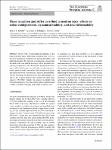The structure and stability of massive hot white dwarfs
| dc.contributor.author | Nunes, Silvia P. | |
| dc.contributor.author | Arbañil, José D. V. | |
| dc.contributor.author | Malheiro, Manuel | |
| dc.date.accessioned | 2021-11-18T06:42:51Z | |
| dc.date.available | 2021-11-18T06:42:51Z | |
| dc.date.issued | 2021-09-09 | |
| dc.identifier.citation | Nunez, A. P., Arbañil, J. D., & Malheiro, M. (2021). The structure and stability of massive hot white dwarfs. The Astrophysical Journal, 921(138). https://doi.org/10.3847/1538-4357/ac1e8a | es_PE |
| dc.identifier.uri | https://hdl.handle.net/11537/28468 | |
| dc.description | El texto completo de este trabajo no está disponible en el Repositorio Académico UPN por restricciones de la casa editorial donde ha sido publicado. | es_PE |
| dc.description.abstract | ABSTRACT We investigate the structure and stability against radial oscillations, pycnonuclear reactions, and inverse β-decay of hot white dwarfs. We consider the fluid matter to be made up of nucleons and electrons confined in a Wigner–Seitz cell surrounded by free photons. It is considered that the temperature depends on the mass density considering the presence of an isothermal core. We find that the temperature produces remarkable effects on the equilibrium and radial stability of white dwarfs. The stable equilibrium configuration results are compared with those for white dwarfs estimated from the Extreme Ultraviolet Explorer survey and the Sloan Digital Sky Survey. We derive masses, radii, and central temperatures for the most massive white dwarfs according to the surface gravity and effective temperature reported by the surveys. We note that these massive stars are in the mass region where general relativity effects are important. These stars are near the threshold of instabilities due to radial oscillations, pycnonuclear reactions, and inverse β-decay. Regarding the radial stability of these stars as a function of the temperature, we find that it decreases with the increment of central temperature. We also find that the maximum-mass point and the zero eigenfrequencies of the fundamental mode are determined at the same central energy density. Regarding low-temperature stars, pycnonuclear reactions occur in similar central energy densities, and the central energy density threshold for inverse β-decay is not modified. For Tc ≥ 1.0 × 108 [K], the onset of radial instability is attained before pycnonuclear reaction and inverse β-decay. | es_PE |
| dc.format | application/pdf | es_PE |
| dc.language.iso | eng | es_PE |
| dc.publisher | IOP Publishing | es_PE |
| dc.rights | info:eu-repo/semantics/closedAccess | es_PE |
| dc.source | Universidad Privada del Norte | es_PE |
| dc.source | Repositorio Institucional - UPN | es_PE |
| dc.subject | Estrellas | es_PE |
| dc.subject | Estabilidad | es_PE |
| dc.subject | Calor | es_PE |
| dc.title | The structure and stability of massive hot white dwarfs | es_PE |
| dc.type | info:eu-repo/semantics/article | es_PE |
| dc.publisher.country | GB | es_PE |
| dc.identifier.journal | The Astrophysical Journal | es_PE |
| dc.description.peer-review | Revisión por pares | es_PE |
| dc.subject.ocde | https://purl.org/pe-repo/ocde/ford#2.07.00 | es_PE |
| dc.description.sede | San Juan de Lurigancho | es_PE |
| dc.identifier.doi | https://doi.org/10.3847/1538-4357/ac1e8a |
Files in this item
| Files | Size | Format | View |
|---|---|---|---|
|
There are no files associated with this item. |
|||




